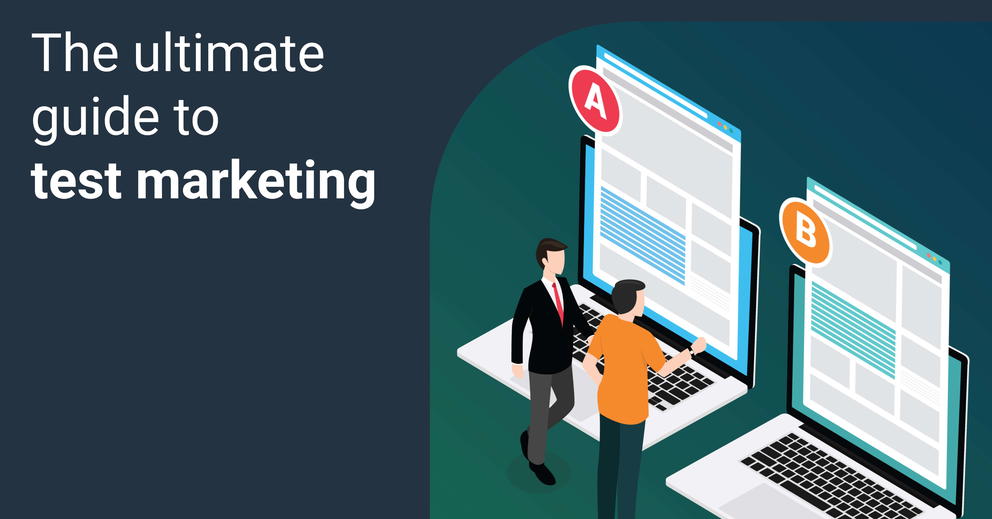What Is Test Marketing & How It Can Help Your Business
Test marketing became an essential part of every successful business. According to Oracle, the average attention span of the consumer is 8 seconds and it’s forecasted to shorten over coming years. These days, one of the biggest marketers’ struggles is to create something eye-catching and engaging.

Aug 04 2021●8 min read

Jeff Bezos, the founder of Amazon, said that focus on customers is the key to a successful business because, in the end, they purchase the company’s product. And when the brand is presenting a new product or service to the market, test marketing allows generating positive and negative feedback to minimize the risk of failure at the initial launch.
What is test marketing?
Test marketing is defined as a strategy used by businesses to check the vitality of their new product, service or a marketing campaign before it is launched on a large scale. This strategy is widely used by businesses worldwide to determine the consumer’s needs and if the business’s product meets the demand.
The experimental campaign can be performed in a selected test market, such as real stores, online stores and social media platforms. In most cases, the experiment is conducted without the customers’ knowledge of their participation to gather non-bias feedback on the product or service.
After collecting the feedback from the test market, the data is then analyzed and the data-backed insights are used to improve the product, service or marketing strategy. For data collection, aggregation and analysis, businesses often use marketing analytics software, which automate the data processes and present the results in an easy-to-understand visual report.
Types of test marketing
There are three types of test marketing — consumer goods test marketing, industrial testing and marketing-effectiveness testing. All three types are used in different test markets with different audiences to gather the most accurate feedback data.
Consumer goods test marketing — all the goods used by consumers directly. The test is conducted to know the consumer’s behavior towards the product. The businesses aim customers to go through the entire testing flow: Trial → Repeat → Adoption → Purchase. To generate the feedback, there are four types of CG (consumer goods) test marketing:
- Sales wave research. This type of test marketing is performed to determine the product’s potential to be consumed every time it is offered to the consumer. The product’s samples are often distributed for free to analyze the consumer’s positivity about the product. A great example would be a perfume sample. When the existing customers purchase the products and receive the sample of the product.
- Simulated market tests are conducted to determine the preference of the customer’s choices. For example, a selected group of people are invited to the store and are given exclusive discounts for specific product categories. The new product is placed together with the old competitor’s products, and customers are observed closely to know if the new product has been picked up when offered jointly with the alternatives.
After the store testing, the tested product is distributed to the group to collect their feedback through an enterprise feedback management software. The market test can also be performed without any selected testing group. Retail stores accept to place the products together with the alternatives and monitor the sales rate.
- A controlled market test is often conducted in the chain stores with the initial launch of the new product. The brand’s new products are often introduced with a testing presentation, sales pitch or an advertising banner to attract potential customers. The controlled market test is different from simulated testing as the product is not distributed for free. The controlled market test allows the brand to advertise the product without giving it away for free, cutting testing costs while at the same time increasing the product’s sales.
- Test markets. Usually, every brand running a test marketing campaign knows the demographics and geographics of their potential customers. A test market is a set of particularly selected areas or segments of the audience used for a small-scale product launch. The feedback collected from the test markets is later analyzed and being used company-wise for product improvement.
Industrial goods are usually used by manufacturers or advanced users. There are two types of testings that help businesses to collect feedback about their product or service:
- Alpha testing is a cost-effective way to gather initial thoughts about the product. The product’s manufacturers distribute their testing prototypes inside the company and ask for feedback from the employees.
Most big-name technology companies use alpha testing before running a beta test. Companies like Apple and Samsung allow employees to test the latest products or software to gather in-house feedback and improve the product before its initial release.
- Beta testing is performed outside the firm with real customers. The beta testing is often conducted in events and exhibitions where the potential product’s users are gathering. It allows the company to collect the thoughts about the product or service with the lowest testing cost.
The marketing-effectiveness test, also known as A/B testing, is commonly used in digital marketing to determine the effectiveness of particular marketing efforts. Marketers run similar campaigns on Google Ads, Facebook Ads or other advertising tools, with different CTA (call to action), visuals or audience targeting to see which advertisements work the best and bring the most value at the lowest ROI (return on investment). A/B tests do not involve consumers directly. They are exposed to only one advertisement. The feedback analysis can be done by collecting the testing data, including click-through, engagement and purchase rates.
The advantages of test marketing
The product or service testing could require an initial investment. However, the data collected will allow businesses to improve and stay on top of the competition. Here are some of the key advantages which companies can benefit from running test marketing:
- It allows getting real insights into how the product would perform in a natural marketing environment. Many things cannot be predicted or anticipated. However, test marketing can highlight the potential issues with a real test in a real-life setting.
- The brand can get an idea of how well the product will be received in the market. Test marketing allows to make more accurate predictions of the wider market, build more realistic advertising budgets and make any improvements needed.
- Determining the most effective marketing channels. A small-scale test can provide an insight on which marketing channels a business’s target customers interact most, helping to set the resources and marketing efforts more wisely when the product initially launches.
- Identifying the best distribution channels and building a data-backed distribution strategy for when the product launches.
- Any weaknesses in the product or service will be exposed without any disastrous outcomes as it was a test-run. The product or service can be improved so that it can be well-received in the market.
- Lastly, the business will get a heads-up if the product or service is going to fail at the initial launch. If the product fails in the test, for example — not well-received by the testing group or lacks interest in it, it is likely that the market will receive the product the same. Sometimes it needs some time to get polished, or the product is simply not powerful enough to compete with the competitors’ alternatives.
Test marketing disadvantages
Although test marketing is one of the most accurate ways to see how well the market will receive the product before launching it publicly, some major disadvantages need to be considered:
- Expensive. Testing is a large-scale project, at the same time measuring different aspects of the business and product. It requires a dedicated budget, which small and average companies might not have.
- Time-consuming. It takes time to set up the campaign and run it to get the feedback.
- The results can be misleading. Even after collecting the results, they can be biased or inaccurate. If the testing group is too small or narrow, the business ends up with a one-dimensional view of the market, which doesn’t reflect reality.
Bottom line
A marketing test allows businesses to see whether the product or service will be well-received in the market and avoid any potential risks the brand may face. Many methods of testing can be implemented in the business strategy based on marketing principles. However, what matters the most, are the insights made from the collected feedback.
Using the right reporting tools allows businesses to make data-backed decisions easier and cut time on routine data collection and visualization tasks. The reporting tool can provide the test run data for marketers in an easy-to-digest, visual report, so they can determine what marketing efforts work best.

WRITTEN BY
Benediktas KazlauskasBenediktas is a detail-oriented writer with a passion for marketing and technology. Using his vast experience in Business Management and Sales, he approaches every blog with the same idea: How to make readers come back for more?